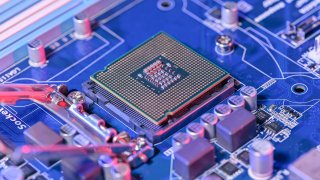
- Taiwan's TSMC and South Korea's Samsung Electronics control more than 70% of the semiconductor manufacturing market.
- A global semiconductor shortage and tensions with China have bolstered U.S. scrutiny of the supply chain and created a drive to regain leadership.
- Under President Joe Biden, the U.S. is looking to bring manufacturing back to American soil and reduce reliance on a handful of chipmakers.
GUANGZHOU, China — If you talk about chipmaking, two companies usually spring to mind — Taiwan's TSMC and South Korea's Samsung Electronics. The two Asian firms combined control more than 70% of the semiconductor manufacturing market.
The U.S., which was once a leader, lags behind in this space after monumental shifts in the business models in the semiconductor industry.
Get DFW local news, weather forecasts and entertainment stories to your inbox. Sign up for NBC DFW newsletters.
But a global semiconductor shortage and geopolitical tensions with China have bolstered Washington's scrutiny of the supply chain, which is concentrated in the hands of a small number of players, and has created a drive to bring manufacturing back to American soil to regain leadership.
The U.S. has earmarked billions of dollars and is reportedly looking at alliances with other nations.
Semiconductors are critical to everything from cars to the smartphones we use. And they have also been thrust into the center of U.S.-China tensions.
Money Report
"One characteristic of US policy is that it has heavy emphasis on China. This has now become a national imperative to enhance self-sufficiency in semis production, accelerated by the recent chip shortages and the 'tech war' against China," Bank of America said in a note published Wednesday.
How Asia came to dominate manufacturing
The key to understanding the geopolitics of semiconductors, which countries dominate and why the U.S. is trying to boost its domestic industry, lies in coming to grips with the supply chain and business models.
Companies like Intel are integrated device manufacturers (IDMs), which design and manufacture their own chips.
Then there are the fabless semiconductor firms, which design chips but outsource manufacturing to so-called foundries. The two biggest foundries are TSMC in Taiwan and Samsung Electronics in South Korea.
Over the last 15 years or so, companies began shifting to this fabless model. TSMC and Samsung took advantage as they began to invest heavily in leading-edge manufacturing technology. Now if a company like Apple wants to get the latest chip for their iPhone produced, they have to turn to TSMC to do it.
TSMC has 55% foundry market share and Samsung has 18%, according to data from Trendforce. Taiwan and South Korea collectively have 81% of the global market in foundries, highlighting the dominance and reliance on these two countries as well as on TSMC and Samsung.
"In 2001, 30 companies manufactured at the leading edge however as semi manufacturing grew in cost and difficulty, this number has fallen to just 3 firms" — TSMC, Intel and Samsung, according to a note from Bank of America published in December.
However, Intel's manufacturing process is still behind that of TSMC and Samsung.
"Taiwan and South Korea have become leaders in wafer fabrication which requires massive capital investment; and part of their success over the last 20 years is due to supportive government policies and access to skilled labour forces," Neil Campling, head of technology, media and telecoms research at Mirabaud Securities, told CNBC by email.
The complex supply chain
While TSMC and Samsung are the dominant manufacturers of semiconductors, they still rely heavily on equipment and machinery from the U.S., Europe and Japan.
The companies that make these tools required by foundries are known as semiconductor capital equipment vendors or "semicap" for short.
The top five semicap equipment vendors make up nearly 70% of the market, according to Bank of America, citing Gartner data. Three of the five are U.S. companies, one is European and one is Japanese.
Netherlands-based ASML is the only company in the world that can make so-called extreme ultraviolet (EUV), which is required to make the most advanced chips such as those manufactured by TSMC and Samsung.
What is the U.S. planning and why?
So, the U.S. is not necessarily falling behind in the semiconductor industry as a whole. Some of its firms are integral to the supply chain. But one area it has lagged in is manufacturing.
Under President Joe Biden, the U.S. is looking to regain leadership in manufacturing and secure supply chains.
In February, Biden signed an executive order which involves a review of the semiconductor supply chain to identify risks. As part of a $2 trillion economic stimulus package, $50 billion was earmarked for semiconductor manufacturing and research. A bill known as the CHIPS for America Act is also working its way through the legislative process and aims to provide incentives to enable advanced research and development and secure the supply chain.
Meanwhile, U.S. firm Intel last month announced plans to spend $20 billion to build two new chip factories and said it will act as a foundry. This could offer a domestic alternative to the likes of TSMC and Samsung.
Part of that scrutiny on the supply chain has been prompted by a global chip shortage that's hit the automotive industry. The coronavirus pandemic accelerated demand for personal electronics like laptops and games consoles just as industrials and automakers wound down production. But a rebound in production plus heightened demand for chips in various sectors has triggered a shortage.
The concentration of production in the hands of TSMC and Samsung has worsened the problem.
The semiconductor supply shortage "has probably made the U.S. administration realise they aren't in control of their own destiny," according to Mirabaud Securities' Campling.
But there are also geopolitical factors at play, informing U.S. policy.
"Over the longer-term, the Biden administration wants to continue to encourage both foreign and U.S. semiconductor manufacturers to expand capacity in the U.S., to reduce dependence on manufacturing in geopolitically sensitive areas such as Taiwan, and create high paying engineering jobs in the U.S.," Paul Triolo, head of the geo-technology practice at Eurasia Group, told CNBC by email.
Part of the U.S. policy in the semiconductor space involves forming alliances. Earlier this month, the Nikkei reported that the U.S. and Japan will cooperate on supply chains for critical components like semiconductors. The two sides will aim for a system where production is not concentrated on specific regions like Taiwan, the Nikkei said.
"The U.S. is trying to cut China out of the equation," Abishur Prakash, a geopolitical specialist at the Center for Innovating the Future, a Toronto-based consulting firm, told CNBC via email.
"It is trying to redesign how the world's chip industry works in the face of a rising China. This is not necessarily about self-sufficiency, although Washington would welcome this. Instead, it is about building up critical sectors — from AI to chips — that are insulated from geopolitics. And, because several nations share U.S. concerns about China, the U.S. is taking a chunk of the world with it."
China's push for self-sufficiency
China meanwhile is trying to push self-sufficiency amid U.S. moves to cut it off from key supplies. Over the past few years, China has tried to boost its semiconductor industry through huge investments and incentives like tax breaks.
But China remains well behind everywhere else and that goes back to the supply chain. SMIC is China's largest foundry, a competitor to the likes of TSMC and Samsung. But SMIC's technology is several years behind that of its Taiwan and South Korean rivals.
And even if it wanted to advance, it's extremely difficult due to U.S. sanctions and actions. Washington put SMIC on a blacklist known as the Entity List last year. That restricts American companies from exporting certain technology to SMIC, holding back the chipmaker due to the key role U.S. firms play in the semiconductor supply chain. Roughly 80% or more of SMIC equipment comes from U.S. vendors, according to Bank of America.
Last year, Reuters reported that the U.S. pressured the Netherlands government to stop the sale of an ASML machine to SMIC. The Dutch firm is the only company that makes the so-called extreme ultraviolet (EUV) machine that is needed to make the most cutting-edge chips. That machine has still not been shipped to China.
"If China wants to manufacture leading edge chips, it is virtually impossible without equipment from the US or allies," Bank of America said in its December note.
"We remain skeptical about a meaningful progress in China's progress due to US restrictions as it is materially behind in IP (intellectual property) and has limited access to IP given the US restrictions," Bank of America said in a separate note last week.
"Our team expects a delay of around 5+ years before it makes a more significant progress."






